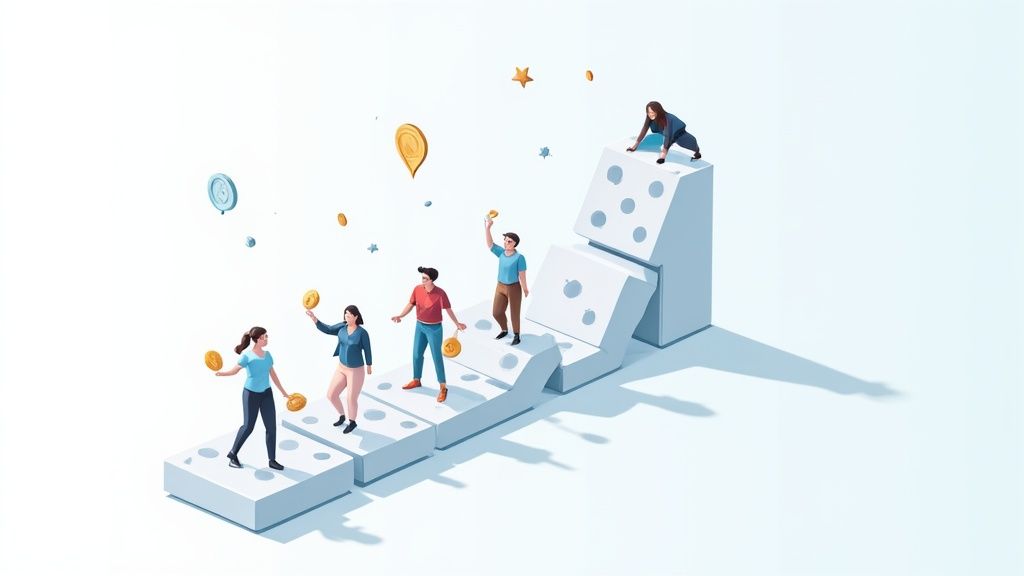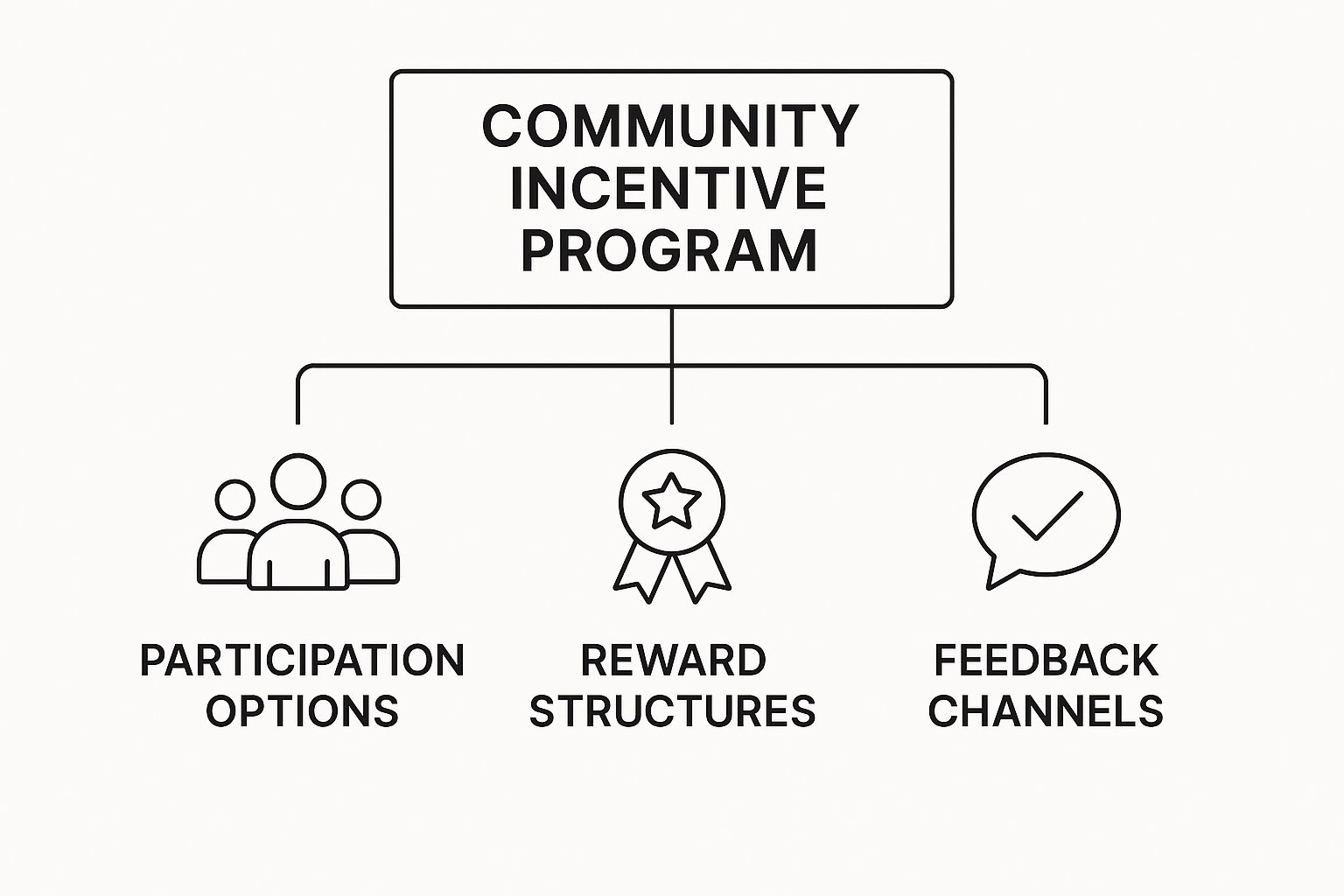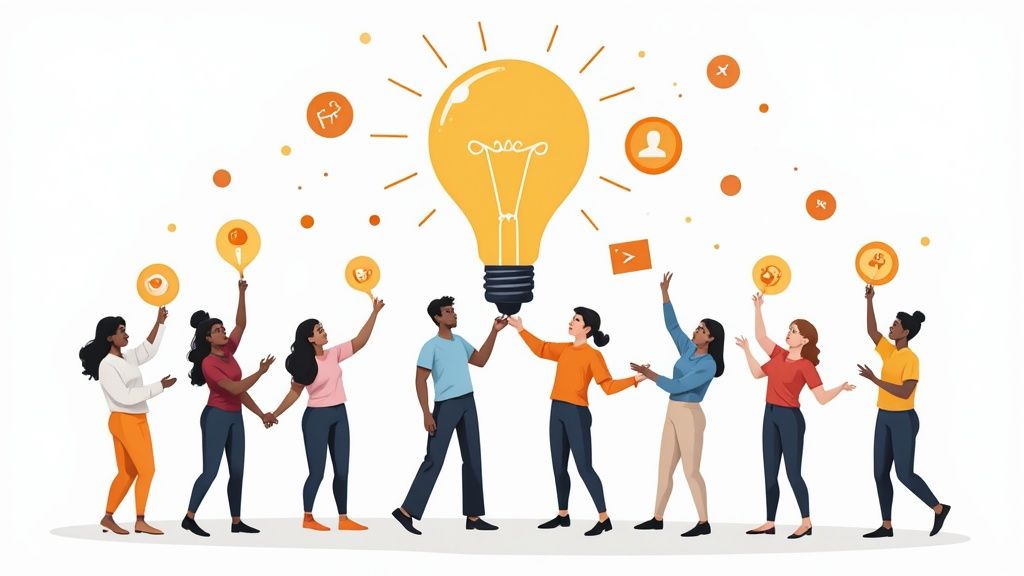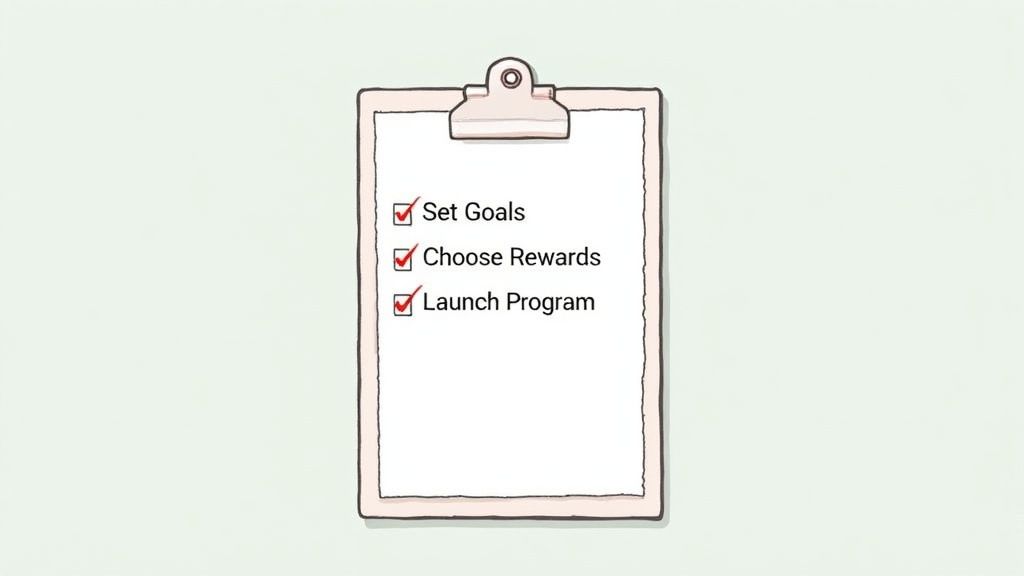Your Guide to a Community Incentive Program

So, what exactly is a community incentive program?
Think of it less like a one-off giveaway and more like a strategic partnership between a project and its biggest supporters. It's a structured system designed to reward people for contributions that genuinely help the project grow and thrive.
What Is a Community Incentive Program Anyway?
Ever look at a project and wonder how they managed to build such a passionate, ride-or-die community? The secret sauce is often a well-thought-out community incentive program. It's a framework for recognizing and rewarding the specific actions that push a project forward, turning passive followers into active builders.
This isn't about just tossing out freebies. It's about creating a two-way street where both the project and the community get real value. The whole point is to build a powerful growth engine that runs on authentic participation, not just empty clicks or transactions.
The Core Idea Behind Incentives
At its heart, an incentive program answers the community's unspoken question: "What's in it for me?" When you give them a clear and compelling answer, you motivate them to invest their time, creativity, and energy into your ecosystem.
It’s a bit like a video game. Players complete quests to earn experience points, unlock new levels, and get cool loot. A community incentive program works the same way. Members complete "quests"—like creating killer content, referring their friends, or giving sharp feedback—to earn meaningful rewards.
This completely changes the dynamic from a one-way broadcast (project shouting at its audience) to a genuine collaboration (project and community building side-by-side). It creates a powerful sense of shared ownership and purpose.
This strategic alignment is what separates a truly effective program from a forgettable marketing campaign. It’s not just about a temporary spike in engagement; it's about building loyalty and value that lasts.
The image below breaks down how these programs are typically structured, showing the relationship between how people participate, what they get in return, and how feedback keeps the whole system healthy.

As you can see, a great program gives members clear pathways to contribute and get recognized for their efforts.
Let's break down the key pieces that make these programs tick. The table below gives a quick look at the essential elements that form an effective incentive program, from the types of rewards offered to the behaviors they inspire.
The Anatomy of a Modern Incentive Program
| Component | What It Is | Why It Matters |
|---|---|---|
| Tasks & Actions | The specific, valuable activities you want your community to perform (e.g., create content, refer users). | This directs community energy toward actions that directly support your project's goals, like growth or awareness. |
| Rewards | The tangible or intangible benefits members receive for completing tasks (e.g., tokens, NFTs, exclusive access). | This is the core motivator. The right rewards make participation feel worthwhile and exciting. |
| Tracking & Attribution | The system for monitoring who did what and ensuring they get credited for their contributions. | Trust is everything. A transparent and accurate system ensures the program is fair and keeps members engaged. |
| Communication | The channels and messaging used to announce tasks, celebrate winners, and gather feedback. | Clear communication keeps everyone on the same page, builds excitement, and makes the community feel connected. |
Each of these components is a critical gear in the machine. When they all work together smoothly, you create a self-sustaining ecosystem of contribution and growth.
What Kinds of Contributions Get Rewarded?
The best part about a modern incentive program is its flexibility. You can reward pretty much any action that helps you hit your project's goals. Some of the most common examples include:
- Content Creation: Rewarding people for writing insightful blog posts, creating slick video tutorials, or even just making hilarious memes that spread the word.
- Social Engagement: Giving kudos for things like sharing big announcements on social media, sparking great conversations in Discord, or hosting community-led AMAs.
- Technical Contributions: For open-source projects, this is huge. It can mean rewarding developers for submitting code, squashing bugs, or improving documentation.
- Feedback and Testing: Offering rewards to members who participate in beta tests, hunt down issues, and provide invaluable feedback to make the product better.
By rewarding a wide range of activities, you open the door for everyone to contribute in a way that plays to their strengths. This inclusivity is crucial for building a vibrant, resilient community where every single member feels seen and appreciated for what they bring to the table. A well-designed community incentive program ensures no valuable action, big or small, goes unnoticed.
Why Web3 Projects Live or Die by Incentives

In Web3, "community" isn't just fluffy marketing talk—it’s the entire foundation. Traditional companies are built from the top down, but Web3 projects are decentralized. This means their survival hinges on a bunch of people voluntarily choosing to show up and participate.
This is where a community incentive program becomes absolutely essential. It’s not some bonus feature you tack on later. It’s the engine that drives growth, keeps people involved, and ultimately determines if the project makes it. Without a good reason for people to contribute, a decentralized network is just an empty building with the lights on.
From Passive Users to Active Owners
The biggest change incentives bring about is turning "customers" into "owners." Think about the old way: a company makes a product, a customer buys it, and the relationship pretty much ends there. It's purely transactional.
Web3 completely flips that around. When you reward people with tokens or other on-chain assets for participating, you’re giving them a real piece of the pie. They aren't just using your app anymore; they're co-owners who are financially and emotionally invested in seeing it succeed.
This shift is huge. When your community members have a stake in the outcome, their goals become your goals. A win for the project is a win for them. That creates a kind of loyalty and evangelism that traditional brands can only dream of.
This ownership mindset is what gets people to do more than the bare minimum. They don't just use the platform; they tell their friends about it, defend it online, and actively look for ways to make it better.
Bootstrapping the Network Effect
Every new project runs into the classic "chicken-and-egg" problem. A decentralized exchange needs people to provide liquidity to be useful. A social platform needs creators before it has an audience. But who’s going to be the first one to show up to an empty party?
Incentives are the solution. They give that initial nudge to get the flywheel spinning. Early adopters get rewarded for taking a chance and providing value when the network is at its most fragile.
Just look at how incentives kickstart these critical early-stage activities:
- Providing Liquidity: DeFi protocols offer token rewards to anyone who deposits assets, making sure the platform actually has the funds it needs to operate.
- Participating in Governance: DAOs (Decentralized Autonomous Organizations) reward members for voting on proposals, ensuring the project is actually guided by an active community.
- Creating Initial Content: A new decentralized social app might reward its first 1,000 users for posting good content, filling the feed so it's not a ghost town for everyone who comes later.
A smart community incentive program solves this "cold-start" problem by giving people a crystal-clear reason to get involved and build together from the very beginning.
Building a Defensible Moat
In the open-source world of Web3, anyone can copy your code in a heartbeat. What they can't copy is a passionate, engaged, and loyal community. That community becomes your strongest competitive advantage—your moat.
Incentives are the bricks and mortar for building that moat. By consistently rewarding people for adding value, you create a dedicated user base that has zero reason to jump over to a competitor. They've got skin in the game, a history with the project, and a social connection to the very ecosystem they helped create. That’s the ultimate defense against copycats and market swings, ensuring a project doesn't just launch, but lasts.
Designing an Incentive Program That Actually Works

So, you’re sold on the idea of a community incentive program. Awesome. Now comes the fun part: actually building one that doesn't fizzle out after a week.
An effective program isn’t just about tossing rewards into the crowd and hoping for the best. It’s a well-oiled machine built with clear goals, desirable rewards, and rules everyone can get behind.
Think of it like building a bridge. You wouldn't just start nailing planks together and hope you reach the other side. You'd need a solid blueprint—knowing exactly where you're starting, where you're going, and how you’ll connect the two points safely. Your incentive program needs that same level of thoughtful planning to link your project's goals with what gets your community excited.
Define Your Goals and Key Actions
First things first, before you even whisper the word "rewards," you have to answer a crucial question: "What do we actually want our community to do?"
If you can't answer this with laser-like focus, you'll end up rewarding a bunch of random activity that doesn't move the needle. Get specific. Your goals should be tied to real, measurable outcomes that contribute to your project's growth.
Once you’ve nailed down your main objective, you can work backward to pinpoint the specific actions that will get you there. This creates a super clear path from community effort to project success.
Here’s what that looks like in practice:
- Goal: Blow up brand awareness on social media.
- Actions to reward: Creating killer video content about your project, landing a viral post with a set number of retweets, or designing slick, shareable infographics.
- Goal: Get more users for your new app.
- Actions to reward: Referring new people who actually finish the onboarding process, writing glowing reviews on app stores, or hosting a tutorial for newbies.
- Goal: Make the product better with user feedback.
- Actions to reward: Submitting super-detailed bug reports, jumping into user testing sessions, or suggesting new features that make it into the next release.
By focusing on these kinds of specific actions, you’re essentially handing your community a playbook for success. They know exactly how to contribute in a way that truly matters.
Choose Rewards That Resonate
Next up, you need to figure out what you're offering in return. Let me tell you, the best rewards aren't always the most expensive. They're the ones your community genuinely wants. A lame reward can make even the most well-designed community incentive program fall completely flat.
The trick is to offer a mix of goodies that appeal to all the different kinds of people in your community.
The secret sauce is aligning the reward with the effort. A small action, like a retweet, might earn a few points. But a massive contribution, like building a whole new tool for the ecosystem, should come with a much bigger prize. This makes the whole system feel fair and worth participating in, no matter the level of involvement.
Consider blending a few different types of value to keep things interesting:
| Reward Category | Examples | Best For |
|---|---|---|
| Financial | Tokens, stablecoins, NFTs | Motivating high-effort tasks and giving members a real financial stake in your project's success. |
| Access-Based | Exclusive Discord channels, early access to new features, 1-on-1 calls with the founders. | Making your top contributors feel like true insiders and VIPs. |
| Status & Recognition | Special community roles ("DAO Guardian," "OG Member"), leaderboard rankings, public shout-outs. | Fueling friendly competition and celebrating your community champs without breaking the bank. |
| Physical Goods | Limited-edition branded merch like hoodies, hats, or custom hardware. | Creating a tangible connection to the project and turning your biggest fans into walking billboards. |
When you mix and match these categories, you create a dynamic and sustainable reward system that keeps people hooked for the long haul.
Establish Fair and Transparent Rules
In Web3, trust is everything. If your community members think the rules are confusing, unfair, or always changing, they’ll peace out. Fast. The guidelines for your program need to be crystal clear, easy for anyone to find, and applied the same way for everyone. No exceptions.
This means spelling out exactly how points are earned, how winners are picked, and what kind of behavior will get someone disqualified. When you launch a program, you want to build positive momentum, and that starts with making sure everyone feels like they have a fair shot. For a deeper look at this, check out our guide on how to build project momentum—fairness is a huge piece of that puzzle.
A transparent system isn't just about avoiding arguments. It's about building a culture of trust that will benefit your project for years. When people know the game is fair, they’re way more excited to play.
How Web3 Gave Traditional Loyalty Programs a Serious Upgrade

Incentive programs have been around forever. We've all seen them. The coffee shop punch card, the airline miles you meticulously save for a dream vacation—these are the OGs of community incentives.
The psychology behind them is simple and timeless: reward people for sticking around, and they'll build a habit. But what Web3 has done is take this tried-and-true idea and wire it into the blockchain, transforming it from a simple marketing trick into something far more powerful. It’s the difference between a flimsy paper card and a dynamic digital asset that you actually own.
This isn't just a minor tweak. It fundamentally changes the relationship from a one-way street (company to customer) into a genuine partnership where the community is woven into the project's success.
The Old Way vs. The New Way
Let's be honest, traditional loyalty programs were all about one thing: getting you to spend more. It was a closed loop. You buy, you get points, you redeem those points for a small discount. Effective? Sure. But it was also incredibly one-dimensional, with the company holding all the cards.
Web3 incentive programs completely smash that model. Instead of just rewarding purchases, they recognize and reward a whole spectrum of valuable contributions. Did you create some great content? Participate in a governance vote? Provide thoughtful feedback? In the new world, those actions are just as valuable as a sale—sometimes even more so.
The real kicker here is ownership. Old-school points are just numbers sitting in a company's database. They can be changed, devalued, or wiped out with a policy update. Web3 rewards, on the other hand, are often tokens or NFTs—digital assets that live in your wallet. You own them. You control them.
This shift gives community members a real, tangible stake in the game. Suddenly, everyone's interests are aligned in a way legacy systems could never quite manage.
Supercharging Familiar Concepts with Blockchain
A lot of the core ideas from traditional loyalty are still here; they've just been put on steroids. By moving everything on-chain, Web3 adds transparency, automation, and portability that were impossible before.
Here’s how some classic concepts got a modern makeover:
- Tiered Rewards: Remember Gold and Platinum airline tiers? In Web3, your "status" could be tied to holding a specific NFT or a certain number of tokens. The best part? Smart contracts can automatically grant you exclusive access without needing a middleman to check your credentials.
- Personalization: Your local supermarket uses purchase history to send you coupons. A modern community incentive program can look at your on-chain activity to offer hyper-relevant quests and rewards. It’s an experience that feels custom-built for you.
- Referral Programs: Forget clunky discount codes. Web3 referrals can use smart contracts to instantly split token rewards between you and your friend the second they complete a specific on-chain action. It's fast, fair, and totally transparent.
This is more than just a fresh coat of paint; it's a complete reimagining of how projects and their communities create and share value together. And the data backs this up. Research shows that a whopping 84% of consumers are more likely to stick with a brand that offers a loyalty program. The power of rewarding loyalty is undeniable.
The Rise of Points Programs
One of the most popular ways we're seeing this evolution play out is through modern points programs. These systems cleverly blend the simplicity of old-school points with the power of Web3 infrastructure. They've become a go-to strategy for projects to track contributions and build momentum before launching a token.
Points act as a flexible and low-risk way to get an incentive program off the ground and drive real growth from day one. To dive deeper into this, check out our complete guide on why points programs are a winning strategy.
Real-World Incentive Programs You Can Learn From
Theory is great, but let's get our hands dirty. Seeing how incentive programs work in the wild is where the real lightbulb moments happen. By pulling apart a few successful examples, we can move past the buzzwords and see what actually gets people to take action.
Let's look at a few programs from completely different worlds—corporate sales floors, data-driven teams, and the open-source community—to see what made them click.
The Classic: Corporate Incentive Travel
In the business world, incentive travel is the OG community incentive program. Instead of just dangling a cash bonus, companies reward their top sales teams or partners with once-in-a-lifetime trips. We're talking all-expenses-paid journeys to incredible destinations, filled with exclusive events you couldn't book on your own.
Why is this so powerful? Because it offers something money can't easily buy: status, recognition, and amazing memories. These programs are built to forge a real emotional connection to the company. The appeal isn't just the free vacation; it's the public acknowledgment of being the best and the chance to hang out with other top performers.
This space is always evolving, too. A recent study found that a whopping 71% of program planners are seeing huge demand for new, unique destinations. People don't want to go to the same resort year after year. This just proves a universal truth: rewards that feel exclusive and special will always get people more excited. You can dig into the full study on how incentive travel preferences are changing over at siteglobal.com.
The Smart Approach: Data-Driven Sales Contests
Here’s another great example from the corporate world, but with a modern twist. Instead of a basic "winner-take-all" sales contest, smart companies are using data to build more nuanced programs. They track individual performance metrics to offer customized rewards that actually motivate everyone on the team.
Think of it like this, with different tiers of rewards:
- Tier 1 (Top 5%): The big prize—a hefty cash bonus and company-wide recognition.
- Tier 2 (Next 15%): A choice of cool rewards, like high-end electronics or extra PTO.
- Tier 3 (Most Improved): A smaller bonus or gift card to celebrate progress and hard work.
The secret sauce here is that "most improved" category. It’s genius. It stops mid-level performers from getting discouraged and checking out because the top prize feels impossible. It keeps the entire team in the game by giving everyone a realistic goal to shoot for.
This works because it recognizes that motivation isn't a one-size-fits-all deal. By using data to personalize the incentives, companies create a program that feels fair, inclusive, and way more effective at lifting the entire team's performance.
The Web3 Way: ProjectDiscovery’s Open-Source Bounties
Now let's jump into the world of open-source software. ProjectDiscovery, a cybersecurity company, has a brilliant community incentive program that gets developers to contribute to its Nuclei security scanner. They built a system with a public leaderboard and bounties to reward people for their expertise.
Here’s a breakdown of their setup:
- Leaderboards: A public leaderboard puts the top contributors on display, giving them serious bragging rights and visibility in the security community. This plays right into our natural desire for status and respect from our peers.
- Bounties: High-priority tasks get a price tag, anywhere from $50 to $250. A developer can claim an issue, submit a fix, and get paid for their work. This is an incredibly smart way to direct the community's energy exactly where it's needed most.
- Swag and Perks: They don't forget the small stuff. First-time contributors get stickers, and key community members get invites to security conferences.
This program is a masterclass in building a multi-layered system. It blends cash, status, and smaller tokens of appreciation to get all kinds of people involved. It shows they truly get what makes their open-source community tick and have created clear paths for anyone to contribute, get recognized, and be rewarded for making the project better.
Common Pitfalls That Can Sink Your Program
Launching a community incentive program is a huge move, but it's not a magic bullet. I've seen even the most well-intentioned programs backfire spectacularly when a few common traps aren't avoided. Getting this right is the key to building something that actually lifts your community up instead of just creating a mess.
One of the biggest dangers is designing a program that's simply not built to last. It’s so easy to get carried away and promise the world to generate that initial buzz, but this can create a massive headache down the road.
Unsustainable Tokenomics and Rewards
This is a classic trap. It happens when a project floods the market with reward tokens without creating any real, long-term demand for them. Sure, everyone gets excited at first, but as more and more tokens get handed out, the value can plummet. Early believers are left feeling burned.
Think of it like printing too much money. If the supply of rewards keeps outpacing the actual value your community is creating, you're setting yourself up for a crash. The goal should be a balanced economy where rewards hold their value because they're tied to meaningful contributions, not just fleeting activity.
A successful community incentive program must be a marathon, not a sprint. Your reward structure needs to be sustainable for months and years, not just the first few weeks of a flashy launch campaign. If your model burns out too quickly, you risk losing the trust of your most dedicated members.
This is where thoughtful, long-term planning becomes your best friend.
Incentive Farming and Inauthentic Engagement
Another massive pitfall is incentive farming. This is what happens when users figure out how to game your system to max out their rewards with the least amount of genuine effort. They aren't there to support your project; they're just there to extract as much value as they can, as quickly as they can.
You’ll see this pop up in a few ways:
- Bot Activity: Automated accounts spamming social media or completing simple tasks over and over.
- Low-Quality Submissions: Users flooding your program with generic, copy-pasted content just to check a box.
- Sybil Attacks: A single person creating dozens of fake accounts to claim rewards multiple times.
These "farmers" can drain your reward pool dry and completely drown out the voices of your real, passionate community members. The key to fighting this is to design tasks that require genuine thought and creativity—actions that are hard for bots and low-effort users to fake.
Unclear Rules and Shifting Goalposts
Nothing kills motivation faster than confusion. If your community doesn't understand the rules or feels like you're constantly changing them, they will lose trust and tune out. Period.
It's absolutely crucial to set clear, fair, and transparent guidelines from day one. That means precisely defining what counts as a valid contribution and exactly how rewards are distributed.
This principle of clarity applies everywhere. Sales incentive programs, for example, are a powerful tool for driving business growth. Industry analysis shows that well-designed programs significantly boost order volumes and participation by top performers, especially when companies use data to customize their strategies for long-term growth. You can discover more insights on how the right structure drives success on salesandmarketing.com.
The same goes for affiliate marketing, which depends entirely on clear terms. For a closer look at structuring these effectively, you might be interested in our guide to building a successful cryptocurrency affiliate program.
By sidestepping these common mistakes, you can build a resilient program that fosters real, organic community growth.
Got Questions About Your Community Incentive Program? We've Got Answers.
Jumping into a community incentive program can feel like a huge undertaking, and it’s totally normal to have a few questions swirling around. Let's walk through some of the most common ones so you can move forward with confidence.
One of the biggest hang-ups I see is teams struggling to measure success. How do you actually know if all this effort is paying off? The trick is to stop chasing fuzzy metrics like "engagement" and get laser-focused on the specific outcomes you defined from the start.
For instance, if your whole reason for doing this was to get more users, then the only number that really matters is your net new user growth that came directly from the program. Simple as that. Don't let vanity metrics pull you off course.
How Do I Pick the Right Platform?
Another big question is always about the tools. Do you build something from scratch or use a platform that’s already out there? Look, building it yourself gives you ultimate control, but it's a massive resource drain—it's slow, expensive, and needs a ton of upkeep.
Honestly, for most projects, grabbing a dedicated platform is the way to go. You can get your program launched fast, use templates that are already proven to work, and automate all the boring (but crucial) work of tracking contributions and verifying tasks. This lets you be the strategist, not the technician.
A great platform should feel more like a partner than just a piece of software. It needs to make it dead simple to dream up quests, see who's doing what, and hand out rewards fairly—all without needing a developer on speed dial.
How Do We Keep People Engaged for the Long Haul?
Okay, the last big one: how do you stop the initial buzz from dying down? A community incentive program isn't something you can just set and forget. Keeping that momentum going is all about keeping things fresh and exciting.
Here are a few ideas that work wonders:
- Drop New Quests: Regularly add new challenges and tasks. It keeps things from getting stale.
- Run Special Events: Think limited-time campaigns or friendly competitions. These create awesome little bursts of energy.
- Actually Listen to Feedback: Poll your community. Ask them what’s fun and what they want to tackle next.
When you continuously tweak and evolve your program, you build a living, breathing space where your members always have a reason to show up and bring their A-game.
Ready to build a program that actually drives growth, without the technical headaches? With Domino, you can design and launch powerful quest-based campaigns in just a few minutes. Start building your community today.
Level Up Your dApps
Start using Domino in minutes. Use automations created by the others or build your own.
